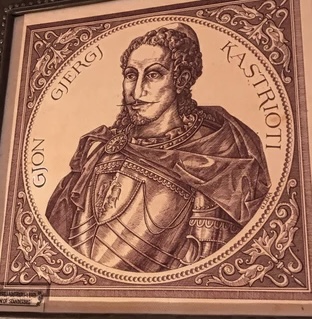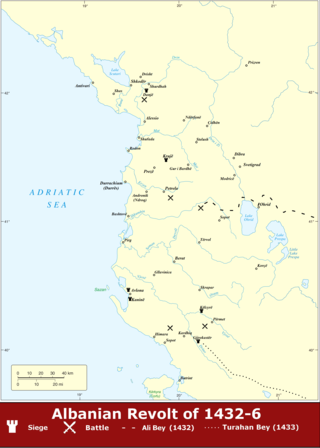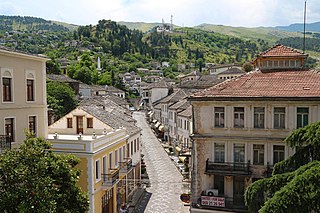History
The village has been inhabited since ancient times where the ruins of the city of Sofa are located near old Tragjas dating to the Illyrian tribes to the IV century BCE. [3]
The village revolted in 1432 and the castle of Sofa was ruined by the Ottomans. The village joined Skanderbeg's rebellion in 1444 and Gjon Boçari from the village built a second castle in the village.
The village continued to join local rebellions during the following years: 1537,1581,1833 and 1847 and in 1912 it supported greatly the Albanian founding fathers.
During World War II, Tragjas was part of the battlefield of the battle of Gjorm, where Albanian resistance units defeated and routed the troops of the Kingdom of Italy. [4]
Tragjas was burned twice during WW2, first by Italians on 7 August 1943 and later by the Nazis on 5 August 1944. [5]

Vlorë is the third most populous city of the Republic of Albania and seat of Vlorë County and Vlorë Municipality. Located in southwestern Albania, Vlorë sprawls on the Bay of Vlorë and is surrounded by the foothills of the Ceraunian Mountains along the Albanian Adriatic and Ionian Sea Coasts. It experiences a Mediterranean climate, which is affected by the Ceraunian Mountains and the proximity to the Mediterranean Sea.

Himarë is a municipality and region in Vlorë County, southern Albania. The municipality has a total area of 571.94 km2 (220.83 sq mi) and consists of the administrative units of Himarë, Horë-Vranisht and Lukovë. It lies between the Ceraunian Mountains and the Albanian Ionian Sea Coast and is part of the Albanian Riviera. The traditionally perceived borders of the Himarë region gradually shrank during the Ottoman period, being reduced to the town of Himarë and the villages of the coastline, generally including only Palasë, Dhërmi, Pilur, Kudhës, Vuno, Iljas and Qeparo.

Gjergj Arianiti (1383–1462) was an Albanian feudal lord who led several successful campaigns against the Ottoman Empire. He was the father of Donika, Skanderbeg's wife, as well as the grand-uncle of Moisi Arianit Golemi. Gjergj Arianiti was Skanderbeg's ally within the League of Lezhë before abandoning the alliance after the defeat in Berat in 1450. He later returned. Robert Elsie emphasizes that Arianiti was often Skanderbeg's rival. He allied with the Kingdom of Naples in 1446, left his alliance with Skanderbeg by 1449 and allied with Venice in 1456. However, his daughter married Skanderbeg and he remained officially part of the League of Lezhe, continuing to fight Ottomans successfully up to his death in 1462.

Margariti is a village and a former municipality in Thesprotia, Epirus, Greece. Since the 2011 local government reform it is part of the municipality Igoumenitsa, of which it is a municipal unit. The municipal unit has an area of 149.223 km2. Population 1,931 (2021).

Borsh is a maritime village, in the Albanian Riviera, in the former Lukovë municipality, Vlorë County, Albania. At the 2015 local government reform, it became part of the Himarë municipality. The village is inhabited by ethnic Albanians, many of whom have traditionally been Bektashi. In Borsh, the Lab dialect of Albanian is spoken.

In 1997, Albania experienced widespread civil unrest due to economic problems caused by the collapse of pyramid schemes. The large sums of money siphoned from the government to fund these schemes led to the collapse of the Democratic Party's government in January 1997. The conflict, which lasted until August 1997, resulted in the deaths of more than 2,000 people. The establishment of a new government occurred as revolutionaries surrounded Tirana. Various sources also describe the ensuing violence as a rebellion or even a civil war.

Mustafa Merlika-Kruja was one of the signatories of the Albanian Declaration of Independence. He was Prime Minister of Albania during the Italian occupation from December 4, 1941, to January 19, 1943.

Orikum is a town and a former municipality in Vlorë County, southwestern Albania. With the 2015 local government reform, it became a subdivision of the municipality Vlorë. It was named after the ancient city Oricum, which was located 4 km west of modern Orikum. The population at the 2011 census was 5,503. The municipal unit consists of the town Orikum and the villages Dukat Fushë, Dukat, Tragjas and Radhimë.

Horë-Vranisht is a village and a former municipality in the Vlorë County, southwestern Albania. At the 2015 local government reform it became a subdivision of the municipality Himarë. The population at the 2011 census was 2,080. The municipal unit consists of the villages Vranisht, Kuç, Bolenë, Kallarat and Tërbaç.

Borsh Castle also known as Sopot Castle from the hill it is located, is a ruined castle near the village Borsh, Albania, near the coast of the Ionian Sea. Inside the castle is the 17th-century Hajji Bendo Mosque from Ottoman times.
Ismail Boçari was an Albanian professor of medicine. During World War II he took part in the Albanian National Liberation Front. He has received several awards for his activities.

The Castle of Gjon Boçari is a castle of the 16th and 17th century in Tragjas, Albania.
Botsaris or Mpotsaris is a surname. Notable people with the surname include:
Skënder Muço (1904–1944) was an Albanian lawyer and leader of Balli Kombëtar, one of the most important resistance organizations in Albania during World War II. Along with Musine Kokalari Muço founded the first social democratic party of Albania in 1943. In 1944 he was ambushed by German troops near Vlorë and executed three days later.
The Albanian revolts of 1833–1839 took place in Albania as a reaction against the new centralizing policy of Ottoman administration.

Gjon II Kastrioti, was an Albanian prince and the son of Gjergj Kastrioti Skanderbeg, the Albanian national hero, and of Donika Kastrioti, daughter of the powerful Albanian prince, Gjergj Arianiti. He was for a short time Lord of Kruja after his father's death, then Duke of San Pietro in Galatina (1485), Count of Soleto, Signore of Monte Sant'Angelo and San Giovanni Rotondo. In 1495, Ferdinand I of Naples gave him the title of the Signore of Gagliano del Capo and Oria. While in his teens, he was forced to leave the country after the death of his father in 1468. He is known also for his role in the Albanian Uprisings of 1481, when, after reaching the Albanian coast from Italy, settling in Himara, he led a rebellion against the Ottomans. In June 1481, he supported forces of Ivan Crnojević to successfully recapture Zeta from the Ottomans. He was unable to re-establish the Kastrioti Principality and liberate Albania from the Ottomans, and he retired in Italy after three years of war in 1484.

The Mataranga, Matranga or Matrangolo were an Albanian noble family during the 13th and 15th centuries. Members of this family included local rulers, Byzantine officials and writers. After the occupation of Albania by the Ottoman Empire, part of the family emigrated to Italy and settled in the Arbëresh villages of Piana degli Albanesi and Santa Cristina Gela in Southern Italy, where they have continued to maintain the Arbëresh language.

The Albanian revolt of 1432–1436 was a series of conflicts between Albanian rebels and the Ottoman Empire during the early period of Ottoman rule in the region. Prompted by the replacement of large parts of the local nobility with Ottoman landowners, centralized governance, and the Ottoman taxation system, the population and the nobles, led principally by Gjergj Arianiti, revolted against the Ottomans.

Gjirokastër is a city in southern Albania and the seat of Gjirokastër County and Gjirokastër Municipality. It is located in a valley between the Gjerë mountains and the Drino, at 300 metres above sea level. Its old town is a UNESCO World Heritage Site. The city is overlooked by Gjirokastër Fortress, where the Gjirokastër National Folk Festival is held every five years. It is the birthplace of former Albanian communist leader Enver Hoxha, and author Ismail Kadare.
Kranë is a village in Vlorë County, southern Albania. At the 2015 local government reform it became part of the municipality of Finiq. It is inhabited solely by Greeks.















